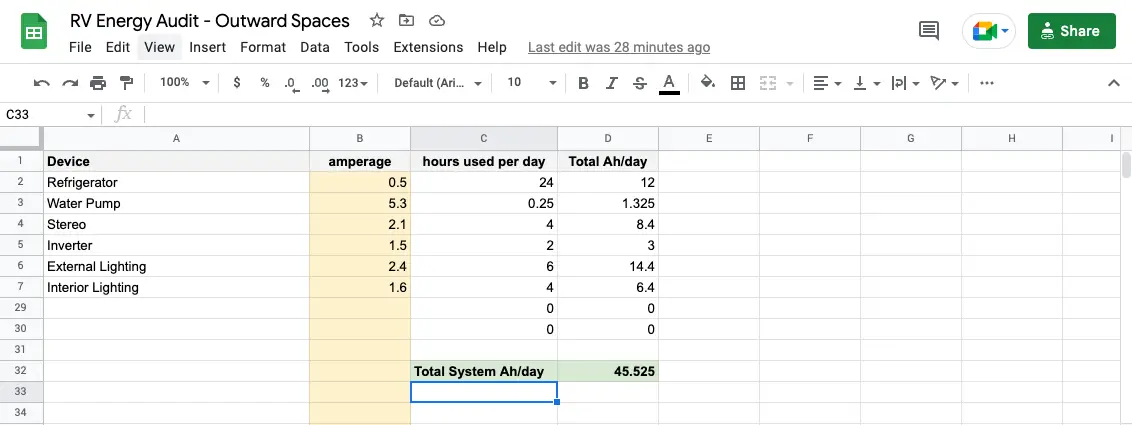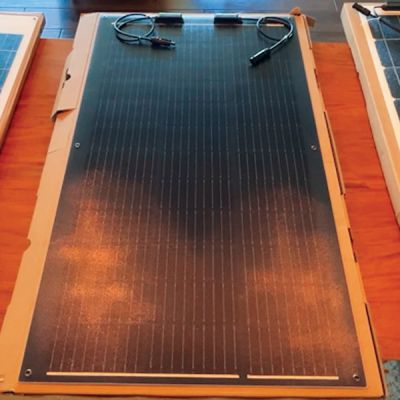How to Conduct an Energy Audit on a Recreational Vehicle

When exploring wild spaces in an RV, van, travel trailer, or boat, it’s important for your vehicle to have an electrical system that will keep your systems running for the duration of your trip. If your vehicle’s electrical system isn’t up to the task or if you want to upgrade your power capabilities, it’s vital to start with an energy audit. A complete energy audit will provide important information about your electrical system to help you make the right choices for your vehicle, usage, and budget.
What is an Energy Audit?
An energy audit is a comprehensive inspection of your energy typically usage used to determine ways to conserve energy or to properly size power systems. In your home, you may hire a professional to conduct an energy audit to look for opportunities to save energy or to size a solar system. For an RV, van, travel trailer, or other off-grid outdoor vehicles, an energy audit can help you determine the size of batteries or the number of solar panels you need.
Conducting an energy audit looks at all of your electronic devices, how much you use them, and helps establish a target amount of power you’ll need to power your devices. For recreational vehicles, this target power number is usually calculated in amp hours per day. For example, you might conduct an energy audit and determine that when you’re boondocking, or camping off-grid, your RV typically uses 50 Ah of power per day.
Benefits of Conducting an Energy Audit on your RV, Van, or Travel Trailer
1. An Energy Audit Determines Your Power Storage and Power Generation Needs
Each of us uses power differently. Some vigilantly turn off lights and other devices when they aren’t in use. Others prefer to have every electronic luxury all going at the same time. Conducting an energy audit on your RV, van, travel trailer, or boat based on how you use it will calculate your unique power needs. Once you know how much power you use, you can ensure your batteries, solar panels, or generator are sized appropriately.
2. An Energy Audit helps you Better Understand your Electrical System
Whether you purchase an RV or build your own electrical system for your van, it’s important to know how your electrical system is designed and how much each device uses. An energy audit provides you with this information per device.
3. An Energy Audit Identifies What Devices Should be Upgraded to be More Energy Efficient
Knowing what each device in your electrical system consumes lets you make better decisions about your system. Discovering which devices consume a large percentage of your power will help identify which device upgrades will save the most power and allow you to extend your trips.
How to Conduct an Energy Audit
Step 1: Measure the Current Draw of Each of your Devices
Most RV, van, travel trailer, or boat electrical systems have a battery monitor. Some smaller or older systems have only a voltage meter (voltmeter) – allowing you to “guess” your battery capacity percentage based on the voltage of your batteries. To conduct an energy audit, a voltmeter won’t do the trick. You’ll need a device that can measure the current (in amps) of each device.

If you don’t have a system monitor that can measure amperage draw, we recommend picking up Renogy’s 500A Battery Monitor (Read our full review of the Renogy Battery Monitor). At under $100, Renogy’s battery monitor includes a shunt that you install between all of your devices and your battery. This shunt measures the amount of current draw coming out of your battery in real time and displays the result on the battery monitor screen.
Turn off all devices in your system
To measure the current draw of each device, start by turning off all devices in your system. Once all devices have been turned off, your battery monitor should be reading at or near 0 Amps. If your monitor doesn’t read 0 Amps with all devices turned off, check to make sure you haven’t forgotten any. If after double-checking, you still have some current draw in your system, don’t worry. This small amount of power may simply be “parasitic loss” – a small amount of power that your system draws even when off. If your number is more than zero, simply make note of the amount and subtract it from your measurements of each device.
Measure each device
Once you have all devices off, turn one device on and measure its current draw in amps. It’s helpful to have a spreadsheet handy for this step to record your measurements. Make a list of each device in your system and record its current draw in amps next to it. We’ve created a simple spreadsheet to get you started –download it here. You can add and level each device in the first column and record its current draw in the ‘amperage” column.

Step 2: Determine How Much You Use Each Device Per Day
Now that you’ve identified how much power each device in your system uses when it’s on, you’ll need to note how much time you use each device for.
Add your daily usage (in hours) to the spreadsheet under the “hours used per day” column. For devices that are on all the time, like a refrigerator, coming up with these numbers is easy. For intermittent devices, like a water pump, try to project how many minutes you’re water pump is on per day. If you typically use your water pump 10 times per day for an average of 1 minute, then you use your water pump for 10 minutes per day or .167 hours per day.
Imagine an average day
When determining how many hours per day you use each device, we recommend thinking about an average day. – not a day of heavy use for a particular device. For example, use usage numbers from a typical sunny day where you don’t use your lights during the day as opposed to a dark, stormy day where you might use interior lighting during the day.
Error on the high side
To determine your power needs, don’t cheat these numbers. The end result of your energy audit is the projected daily usage total of your system. If you typically use lights for 4hrs/day but want to cut back to 2/hrs per day to save power, enter the higher number for this exercise.
An electrical system that is bigger than you need is better than one that is less than you need – provided you have the budget. If you are going to guess on your usage, guess on the higher side.
Step 3: Establish your daily usage numbers
To establish how much power each device in your system uses per day, multiply the amperage of the device by the number of hours it will be used each day.
Amperage X Hours/Day = Total Amp Hours per Day
If you’re using our spreadsheet, it will do the math for you for each device. In the “Total Ah/day” column, you’ll discover the amount of power each device listed uses in your system. Because batteries are usually labeled in amp hours (Ah), keeping your energy audit recording in Ah will help more easily determine how your usage stacks up against your storage capacity.
Once you have your daily Ah totals for each device, add them all together to discover your total system needs per day in Ah. If you are using our spreadsheet, you’ll find this number at the bottom in green and labeled “Total System Ah/day”.

Now That You Know Your Daily Power Needs, You Can Make Better Decisions About the Future of Your System
Now that you know your usage, you can compare that number to your battery capacity. If you have a 200Ah battery bank, 200Ah of storage divided by 50Ah of daily usage will give you 4 days of power before needing to recharge. If you want to extend the time you can camp off-grid, you may look at adding a solar system. Let’s say you want to target a camping duration of 7 days with your system. For the 3 additional days, you’ll need to generate an additional 150Ah of power. Having 7 days to generate 150Ah of power means you’ll need a solar system that can generate around 21.5 Ah per day.
Knowing your daily power usage may indicate that you need to add to your battery bank or, if that’s not possible, reduce your power usage by using higher-power devices less each day. If your current electrical system doesn’t fit your power needs, you only have 2 options:
- add more power (storage capacity with batteries, charging capacity with solar, generator, etc)
- decrease your power usage (limit your usage, shorten your trip durations, etc)
There are a lot of ways to accomplish either (or both) items above. In the end, you’ll need to decide what alterations your electrical system needs based on your needs and your budget. By conducting an energy audit, you’ll now know exactly how much power each device in your system draws, your daily system usage, and how you’re system should be sized. You’ll have a lot more useful information to make informed decisions to improve your electrical system and to save money in the process.









Leave a Reply